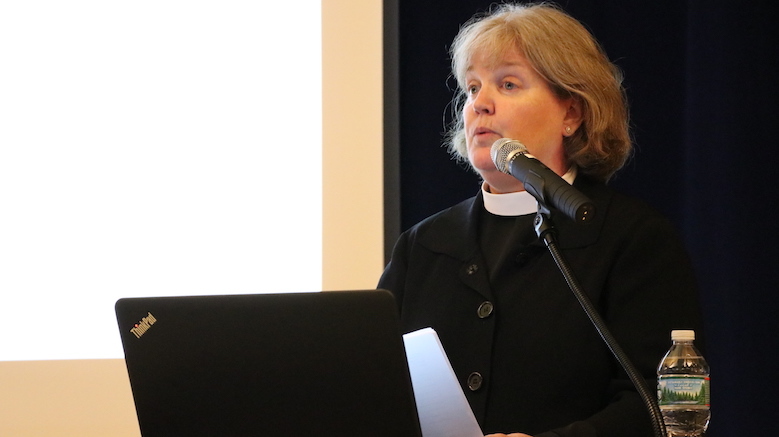If you were to travel 500 miles on foot in a foreign country, what items would you bring in your backpack?
Reverend Anne Gardner, director of the Chapel at Phillips Andover in Massachusetts, who presented St. Joseph’s College’s annual Founders Day lecture, was faced with that excruciating decision eight years ago when she took her pilgrimage across the famous Camino de Santiago in Spain – a nearly 500-mile journey across northern Spain that leads to Santiago de Compostela, where the remains of St. James were discovered in the ninth century.

Michael J. Hanophy, Ph.D. speaks during the Founders Day lecture.
“Just prior to our trip the five of us got together to sort through what we knew we needed to take,” said Gardner, who went on the pilgrimage with a group of co-workers and students. “There were certain essential items we all knew we needed: our backpacks, a sleeping bag, and of course our clothing.”
But on a nearly 40-day hike, there were other items that she wanted to bring and couldn’t – such as clothes, a scarf, jacket, towel, glasses, a cellphone, medical supplies, binoculars, toilet paper and a pillow.
Gardner made large cuts to her backpack’s contents for the trip. She explained that experts recommend a hiking backpack should be no more than 10 percent of its carrier’s weight. Therefore, a 150-pound person should look to bring a 15-pound backpack.
That’s not all: experts also recommend reserving eight pounds of the bag for water to stay hydrated—leaving only seven pounds for personal belongings.
Gardner ultimately only packed one luxury item to give her comfort on the trip: 40 pieces of Bazooka bubble gum.
“The lesson of my backpack wasn’t to ascertain what I needed to take,” Gardner said. “It was to discern how to be free of the things I needed to leave behind.
“Nearly every pilgrim I met brought too much, and straining under the weight would abandon items, even valuable ones, during moments of discomfort or fatigue,” Gardner continued. “That’s what I needed to do, as well.”
Reflecting on the Pilgrimage
During the pilgrimage, Gardner attempted a task even more difficult than trimming down the items in her backpack: letting go of things that were surreptitiously weighing her down. As she walked down the trail, she reflected on the unhealthy aspects in her life that were holding her back—including bad habits, toxic relationships and grudges she held.
Gardner is penning a memoir about the spiritual, emotional and physical challenges of her pilgrimage.
Dr. Michael J. Hanophy, Ph.D., said he was happy to invite his former college classmate to speak at Founder’s Day, the celebration of the 102nd anniversary of SJC, citing her myriad of accomplishments, in addition to the pilgrimage. Gardner’s resume boasts a year of volunteering for the Jesuit Volunteer Corps, known as JVC, where she spent a year at a Montana-based shelter for abused women and children, and employment later on as a social worker to continue helping people with their struggles.
Gardner’s lesson follows suit with the mission of the College that the Sisters of St. Joseph’s established more than a century ago: to prepare each student for a life characterized by integrity, intellectual and spiritual values, social responsibility and service.
“Over the course of those 500 miles, I tried to remember that life is a journey of faith,” Gardner said. “My backpack proved to be a very telling commentary of all the things I thought I needed. Only to learn, that even in the most challenging of circumstances, most of the things that I carry are unnecessary.”

